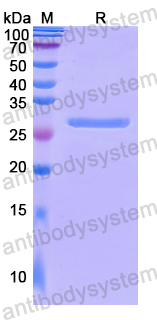Catalog No.
YHG61301
Expression system
E. coli
Species
Homo sapiens (Human)
Protein length
Thr526-Ala745
Predicted molecular weight
27.89 kDa
Nature
Recombinant
Endotoxin level
Please contact with the lab for this information.
Purity
>90% as determined by SDS-PAGE.
Accession
Q13617
Applications
ELISA, Immunogen, SDS-PAGE, WB, Bioactivity testing in progress
Form
Lyophilized
Storage buffer
Lyophilized from a solution in PBS pH 7.4, 0.02% NLS, 1mM EDTA, 4% Trehalose, 1% Mannitol.
Reconstitution
Reconstitute in sterile water for a stock solution. A copy of datasheet will be provided with the products, please refer to it for details.
Shipping
In general, proteins are provided as lyophilized powder/frozen liquid. They are shipped out with dry ice/blue ice unless customers require otherwise.
Stability and Storage
Use a manual defrost freezer and avoid repeated freeze thaw cycles. Store at 2 to 8°C for frequent use. Store at -20 to -80°C for twelve months from the date of receipt.
Alternative Names
Cullin-2, CUL2, CUL-2
Identification and validation of USP15 and CUL2 as ubiquitination related biomarker in chronic obstructive pulmonary disease., PMID:40413536
Neddylation modification stabilizes LC3B by antagonizing its ubiquitin-mediated degradation and promoting autophagy in skin., PMID:40208944
Cul2 Is Essential for the Drosophila IMD Signaling-Mediated Antimicrobial Immune Defense., PMID:40141268
ZYG11B suppresses multiple enteroviruses by triggering viral VP1 degradation., PMID:40135890
An epitranscriptomic program maintains skeletal stem cell quiescence via a METTL3-FEM1B-GLI1 axis., PMID:40016417
Identification of novel 7-hydroxycoumarin derivatives as ELOC binders with potential to modulate CRL2 complex formation., PMID:39881207
Feedback loop centered on MAF1 reduces blood-brain barrier damage in sepsis-associated encephalopathy., PMID:39833662
Reactive oxygen species control protein degradation at the mitochondrial import gate., PMID:39642856
Targeted Degradation of Receptor-Interacting Protein Kinase 1 to Modulate the Necroptosis Pathway., PMID:39539258
Genome Sequencing Identifies 13 Novel Candidate Risk Genes for Autism Spectrum Disorder in a Qatari Cohort., PMID:39519104
Neddylation and Its Target Cullin 3 Are Essential for Adipocyte Differentiation., PMID:39404417
SARS-CoV-2 ORF10 hijacking ubiquitination machinery reveals potential unique drug targeting sites., PMID:39309499
Role of AMBRA1 in mitophagy regulation: emerging evidence in aging-related diseases., PMID:39113560
PRAME promotes proliferation of multiple myeloma cells through CTMP/Akt/p21/CCND3 axis by ubiquitinating CTMP and p21., PMID:39071619
RNF8-mediated multi-ubiquitination of MCM7: Linking disassembly of the CMG helicase with DNA damage response in human cells., PMID:39004272
Targeted Protein Degradation: Current and Emerging Approaches for E3 Ligase Deconvolution., PMID:38981094
TRAF2 associates with cullin neddylation complex assembly., PMID:38978293
Comprehensive analysis of the Cullin family of genes reveals that CUL7 and CUL9 are the significant prognostic biomarkers in colorectal cancer., PMID:38883340
Comprehensive prognostic and immunological analysis of Cullin2 in pan-cancer and its identification in hepatocellular carcinoma., PMID:38787355
Cullin-RING ligases employ geometrically optimized catalytic partners for substrate targeting., PMID:38382526
PRAMEL7 and CUL2 decrease NuRD stability to establish ground-state pluripotency., PMID:38332149
ZSWIM4 regulates embryonic patterning and BMP signaling by promoting nuclear Smad1 degradation., PMID:38177922
CAND1 inhibits Cullin-2-RING ubiquitin ligases for enhanced substrate specificity., PMID:38177676
CRL2APPBP2-mediated TSPYL2 degradation counteracts human mesenchymal stem cell senescence., PMID:38170390
PRAME induces genomic instability in uveal melanoma., PMID:38030788
Macrophage-Derived Factors with the Potential to Contribute to Pathogenicity of HIV-1 and HIV-2: Role of CCL-2/MCP-1., PMID:38005838
USP51 facilitates colorectal cancer stemness and chemoresistance by forming a positive feed-forward loop with HIF1A., PMID:37816999
Circulatory extracellular vesicle derived miR-195-5p promotes cellular apoptosis and suppresses cell proliferation in the buffalo endometrial primary cell culture., PMID:37794118
Defining E3 ligase-substrate relationships through multiplex CRISPR screening., PMID:37735597
Bioinformatics analysis of CUL2/4A/9 and its function in head and neck squamous cell carcinoma., PMID:37695034
Activity-based profiling of cullin-RING E3 networks by conformation-specific probes., PMID:37653169
Ni2+ and Cu2+ complexes of N-(2,6-dichlorophenyl)-N-mesityl formamidine dithiocarbamate structural and functional properties as CYP3A4 potential substrates., PMID:37591990
Identification of KLHDC2 as an efficient proximity-induced degrader of K-RAS, STK33, β-catenin, and FoxP3., PMID:37591251
Targeted kinase degradation via the KLHDC2 ubiquitin E3 ligase., PMID:37567174
Probing the Influence of Novel Organometallic Copper(II) Complexes on Spinach PSII Photochemistry Using OJIP Fluorescence Transient Measurements., PMID:37509094
A positive feedback loop between miR-574-3p and HIF-1α in promoting angiogenesis under hypoxia., PMID:37481161
MicroRNA-154-5p suppresses cervical carcinoma growth and metastasis by silencing Cullin2 in vitro and in vivo., PMID:37397007
Role of SOCS and VHL Proteins in Neuronal Differentiation and Development., PMID:36835292
E3 ligase autoinhibition by C-degron mimicry maintains C-degron substrate fidelity., PMID:36805027
Activity-based profiling of cullin-RING ligase networks by conformation-specific probes., PMID:36711970
Phthalates impact on the epigenetic factors contributed specifically by the father at fertilization., PMID:36694265
E3 ligase Cul2 mediates Drosophila early germ cell differentiation through targeting Bam., PMID:36423673
Differential dynamics of cullin deneddylation via COP9 signalosome subunit 5 interaction., PMID:36423380
Synthesis and antitumor activities of five Cu(II) complexes of bis(5-halosalicylidene)-1,3-propanediamine derivatives., PMID:36352484
ZER1 Contributes to the Carcinogenic Activity of High-Risk HPV E7 Proteins., PMID:36346242
A synthetic KLHL20 ligand to validate CUL3KLHL20 as a potent E3 ligase for targeted protein degradation., PMID:36328355
The N6-methyladenosine-mediated lncRNA WEE2-AS1 promotes glioblastoma progression by stabilizing RPN2., PMID:36168628
NLRC5 restricts dengue virus infection by promoting the autophagic degradation of viral NS3 through E3 ligase CUL2 (cullin 2)., PMID:36126167
Effects of Novel Photosynthetic Inhibitor [CuL2]Br2 Complex on Photosystem II Activity in Spinach., PMID:36078088
Post-translational control of beige fat biogenesis by PRDM16 stabilization., PMID:35978186

